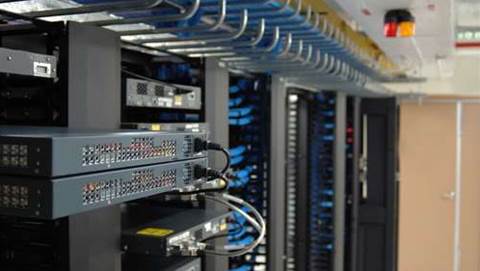Two halls of Fujitsu’s Noble Park data centre will be the first in Australia to carry an official NABERS rating after a complex, six-month audit by Green Global Consulting was approved by the NSW Government.

The NABERS rating for data centres, launched at iTnews’ Data Centre Strategy Summit in February, is a voluntary rating system that measures the power efficiency of a facility by comparing how much of its total power use is used for IT load. The NSW and federal governments introduced the scheme to encourage organisations to adopt energy-saving methods and technologies in their data centres.
Fujitsu has been awarded a very specific four-star NABERS rating for the plant (infrastructure rating) that supplies power and cooling to 20,000+ square metres of server rooms at Building One of Noble Park (Halls 1 and 2), but only after an audit that ran for over six months which put the new NABERS methodology to the test.
Lee Stewart, head of sustainability at Fujitsu Australia, said the company opted to be the first to achieve a rating to validate its efforts to reduce data centre power consumption. It further helps to pre-empt the future demands of federal government clients, in particular.
“You only saw what happened with office buildings - the government decided it wouldn’t be in office buildings with less than three or four stars and overnight property owners had to act," Stewart told iTnews.
"We expect at some stage in the future, governments will stipulate or at least ask the question from us from a data centre perspective."
Fujitsu won’t attempt to get a NABERS rating for its IT load or the entire data centre as it doesn’t have control of what equipment customers choose to put in the co-location facility. Stewart is nonetheless using the NABERS opportunity to coach customers on energy efficient practices, he said.
Timing
NABERS data centre ratings require auditors to validate 12 months of energy readings from facilities. The scheme has only officially been in operation since February.
Frank Roberson, senior project officer at the NSW Department of Environment and Heritage - the caretaker agency for the NABERS scheme - said this was "not an issue."
“The consumption is calculated based on third party verifiable data, most commonly in the form of utility bills," he explained.
"If there are twelve months of energy bills from October 2012 to October 2013, for example, a rating can be completed."
Stewart said Fujitsu has been collecting data on power use for several years, in order to break down the data for billing its outsourcing customers on their power consumption. And while those records “weren’t perfect", Fujitsu had enough data that could be independently verified to get the job done.
The successful award of a NABERS rating makes Bob Sharon, CEO of Green Global Consulting, the first auditor certified under the NABERS for data centres scheme.
Sharon told iTnews he visited Noble Park over 25 times and put in 150 hours of work to achieve the result.
Read on for Sharon's list of important lessons for those facility owners considering a NABERS rating.
Green Global Consulting CEO Bob Sharon said the first official NABERS audit resulted in a lot of lessons for all parties - most of which are scheduled to be discussed at an official de-briefing later this week.
1. Records must be validated
Fujitsu's facilities staff had originally expected printed reports of monthly meter readings would suffice to achieve the rating.
On several occasions, Fujitsu staff had to pull data from various systems to back their claims.
"I would recommend making sure you’re collecting as much data as possible that can be validated easily by an third party," Stewart advised.
“It wasn’t easy. I would recommend that anybody doing an infrastructure rating ensure their metering is in the right spots."
There were delays, for example, when it was discovered Fujitsu had been taking readings from the outbound side of PDUs (power distribution units) but not from master PDUs - which could have made the job much easier.
2. Meter your power and IT load separately
All parties learned that the use of in-row cooling infrastructure - which can drive down cooling costs - can also carry an audit overhead if the power it consumes isn't measured separately to the IT load.
Sharon found at Noble Park a series of rear door extraction fans that - while powered within the same PDU as the IT load - needed to be measured and subtracted for an accurate reading.
If they aren't measured separately, auditors are faced with installing dozens of loggers on individual equipment (at significant cost), or must choose the theoretical maximum 'nameplate' power draw, which could overstate the draw of this infrastructure by up to 400 percent and harm the chances of a good NABERS rating.
“The ‘nameplate’ draw is basically what the manual says - which at full load, might consume 1.2 kW per hour, but some of those extraction fans might only be drawing 300 watts," Sharon said.
"The moral of the story is to have separate metering for all devices that you could record - if you’re not metering them separately, your rating might pay dearly.”
3. Test your equipment
There was a danger during the final stages of the process that Fujitsu may have fallen just short of a four star rating, if not for the discovery of several anomalies.
Fujitsu had recently installed new chillers that were serving both Buildings One and Two at Noble Park. As the data centre rating was limited to Building One, the energy these chillers required to cool the small amount of IT load in Building Two could be deducted.
Further, Sharon experienced difficulties when attempting to read data from one of the CT (current transformers) in a switch port within the distribution board. This would be telling as it would usually be the CT that - wrapped around the phase - is used to measure the current. Sharon confirmed that the white phase from one of the PDUs had not been read during the period of the fault.
Sharon raised the point with NABERS and sought to extrapolate historical data to gauge the impact of this anomaly.
“I argued that as long as we were within a five percent margin of error, the rating would stand," he said. "But - to their credit - I was advised that NABERS doesn’t allow any form of extrapolation."
"There are strict rules around what constitutes acceptable data," explained Robison. "For example, only actual readings can be used - not utility estimates."
Fujitsu's engineers again came to the rescue - pulling data from Branch Circuit Monitoring - a system that measures power use within each individual circuit - that had otherwise been used to charge customers for power usage.
These measurements - far further down the chain than the PDU - provided measurements for the missing white phase across 32 circuits within the range of the affected PDU.
To validate that data, Sharon captured the total power usage for 12 months of the blue and red phase as recorded by both the Branch Circuit Monitoring system and the PDU. They varied within 0.06 percent over 12 months.
Green Global Consulting now had the numbers to give Fujitsu’s Noble Park a four star rating.
Sharon said the long process tested his relationships with both his client (Fujitsu) and the NABERS scheme.
“It’s perfectly natural that the client will get a bit shirty sometimes at how much we needed to test the veracity of their numbers," he said. "The NABERS team gets just as shirty about any effort to extrapolate numbers - they wouldn’t budge an inch. Its all part of the learning curve.”


.png&h=140&w=231&c=1&s=0)




 iTnews Executive Retreat - Security Leaders Edition
iTnews Executive Retreat - Security Leaders Edition












_(1).jpg&h=140&w=231&c=1&s=0)



